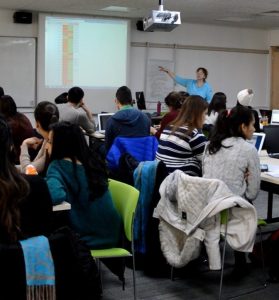
Source: NBrown
I already have a good number of blog posts relating to teaching. I talked about messages from the classroom, about the use of ice breakers, about playing games in lessons, about classroom management, and about teaching international students. I originally wrote all of these posts for classroom settings with typically 30 or so students as the audience. However, I have not ever talked about teaching larger audiences. This is what this post is all about.
What then are some recommendations for teaching to larger audiences?
Break it up:
No matter who is in your room, concentration span will only deteriorate the more populated a room is. Therefore, breaking up the content is always important. My slides tend to be interspersed with opportunities to reflect, to scribble things on poster paper, and to discuss with partners.
Use audience response systems:
I have already shared the benefits of audience response systems in a previous post. And whilst they are great in an ordinary classroom setting, they are fantastically exciting when working with larger audiences. You cannot possibly go around the room and get feedback, not even from smaller group discussions. That is where the audience response systems are offering an opportunity for your larger audiences to get involved, but also to feel closer to you.
Connect with your larger audience:
In a smaller setting it is relatively easy to catch somebody’s gaze and connect, to speak directly to the individuals. Often, with larger audiences we feel overwhelmed with so many eyes set on us that we lose that individual connection. However, that connection with individuals is what allows us to read the room and respond accordingly. Trying to build that connection comes with extra effort with larger audiences, but it is not impossible.
So, let me finish by saying that I really only have one approach to teaching. The principles for my teaching are always the same: being engaging and allowing learners to discuss and connect with one another. And I do not really make a difference between smaller audiences and larger audiences, or who is in my classroom. I have “played” LEGO on the floor with higher education professors just like I would with secondary school pupils.
Leave a message: